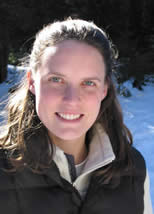Julia Briedis
 Ever since a young age I have enjoyed spending time in the woods of New England. This pastime evolved into a lifelong interest in forested ecosystems. I came to the University of Maine to pursue that interest and through my studies I hope to contribute to the sustainability of the forests and the forest products industry.
Ever since a young age I have enjoyed spending time in the woods of New England. This pastime evolved into a lifelong interest in forested ecosystems. I came to the University of Maine to pursue that interest and through my studies I hope to contribute to the sustainability of the forests and the forest products industry.
When growing up I spent much of my time in the woods of New England. This appreciation for the outdoors is what led me to focus my undergraduate studies on ecology at Bates College. To enrich my college coursework and learn about another part of the world, I traveled abroad to Tanzania for a semester to study the conservation issues and ecology of East Africa. My experiences abroad and throughout college sparked my interest in forestry. Summer internships doing field work with Manomet Center for Conservation Sciences intiated my exploration into the realm of forestry in Maine. For a change of scenery, I moved to the Pacific Northwest where I worked for a Forest Service contractor installing Forest Inventory and Analysis plots. Working much of the time in the rugged terrain of the Cascade mountain range, everyday was its own adventure. Having seen many forests in Oregon and Washington after three years of work, it was time to return home to New England. I came to the University of Maine for a master’s degree in forestry to further pursue my interest in forested ecosystems and hope to eventually contribute to the sustainable management of New England forests.
My Research
Logging residues are an important source of biomass used to produce bioenergy. My project involves determining an estimate for the percentage of logging residue that is recovered during integrated harvests of both energy and conventional products. Due to mechanical and economical constraints, not all forest residue intended to be recovered during a harvest makes it out of the forest. This study, therefore, will quantify the amount of residue remaining on the forest floor following a harvest, which can have implications for the site’s biodiversity and soil nutrients. Since forest residue is a feedstock for the bioenergy industry, it is important to understand not only how much residue is available in Maine’s forests, but how much is recoverable.
In Other Words
Logging residues consist of tree tops and branches and formerly non-merchantable stems either too small to harvest or poorly formed. Without a bioenergy market these residues are generally left in the forest. My research will involve counting and measuring forest residue on harvested sites. The amount that is tallied in the forest can be compared to the amount that was removed from the forest to give a percentage of residue that is recovered by machines during a harvest. By measuring this we can determine how much residue is left in the forest to provide wildlife habitat and replenish soil nutrients.
Contact Information
Nutting Hall, Room 251
University of Maine
Orono, ME 04469
E-mail: julia.briedis@umit.maine.edu
